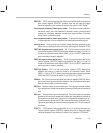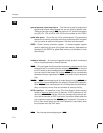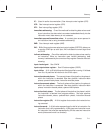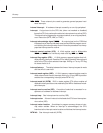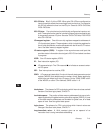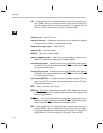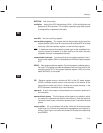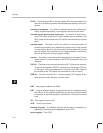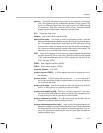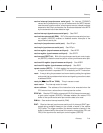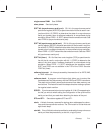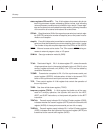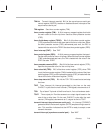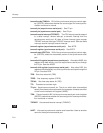
F-17
Glossary
pipeline: A method of executing instructions in an assembly line fashion.
The ’C2xx pipeline has four independent phases. During a given CPU
cycle, four different instructions can be active, each at a different stage
of completion. See also
instruction-fetch phase
;
instruction-decode
phase
;
operand-fetch phase; instruction-execute phase
.
PLL: Phase lock loop circuit.
PM bits: See
product shift mode bits (PM).
power-down mode: The mode in which the processor enters a dormant
state and dissipates considerably less power than during normal opera-
tion. This mode is initiated by the execution of an IDLE instruction. During
a power-down mode, all internal contents are maintained so that opera-
tion continues unaltered when the power-down mode is terminated. The
contents of all on-chip RAM also remains unchanged.
PRD:
Timer period register
. A 16-bit memory-mapped register that specifies
the main period for the on-chip timer. When the timer counter register
(TIM) is decremented past zero, the TIM is loaded with the value in the
PRD. See also
TDDR
.
PRDB: See
program read bus (PRDB).
PREG: See
product register (PREG).
prescaler counter: See
PSC.
product register (PREG): A 32-bit register that holds the results of a multi-
ply operation.
product shifter: A 32-bit shifter that performs a 0-, 1-, or 4-bit left shift, or
a 6-bit right shift of the multiplier product based on the value of the prod-
uct shift mode bits (PM).
product shift mode: One of four modes (no-shift, shift-left-by-one, shift-left-
by-four, or shift-right-by-six) used by the product shifter.
product shift mode bits (PM): Bits 0 and 1 of status register ST1; they iden-
tify which of four shift modes (no-shift, left-shift-by-one, left-shift-by-four,
or right-shift-by-six) will be used by the product shifter.
program address bus (PAB): A 16-bit internal bus that provides the ad-
dresses for program-memory reads and writes.
program-address generation logic: Logic circuitry that generates the ad-
dresses for program memory reads and writes, and an operand address
in instructions that require two registers to address operands. This cir-
cuitry can generate one address per machine cycle. See also
data-ad-
dress generation logic.
Glossary



